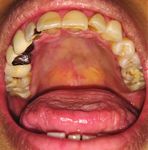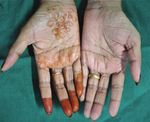Xerostomia - An Unknown Oral Manifestation in AAA Syndrome - Open Journal Systems
←
→
Page content transcription
If your browser does not render page correctly, please read the page content below
Indian Journal of Forensic Medicine & Toxicology, April-June 2021, Vol. 15, No. 2 103
Xerostomia – An Unknown Oral Manifestation in AAA
Syndrome
Deepali Agrawal1, Ravikiran Ongole2
1
Post Graduate Resident, 2Professor and Head, Department of Oral Medicine and Radiology, Manipal College of
Dental Sciences, Mangalore, Manipal Academy of Higher Education, Manipal, Karnataka, India
Abstract
Background: The triple A syndrome (AAAS), also termed Allgrove syndrome (AS), is a very rare chromosome
recessive disorder that was 1st identified in 1978 by Jeremy Allgrove and colleagues in 2 unrelated siblings.
In most cases, there is no associated family history. The syndrome comprises of Achalasia, Addisonianism
and Alacrimia. It has an estimated prevalence of 1 per 1,000,000 individuals. About 200 cases have been
reported worldwide as of date, showing a great variability in severity as well as in clinical manifestations.
Consistent oral findings could be noticed such as high arched palate, oral pigmentation, fissured or atrophic
tongue, and xerostomia
Case report: We report the case of a 25-year-old girl who presented with Triple A Syndrome with all
characteristic clinical features.
Conclusion: The aim of this case report is to highlight the dental involvement in Allgrove syndrome. In
addition, we aim to emphasize the need for the oral physician to accurately diagnose the condition, manage
the oral manifestations, and to collaborate with other dental specialists to provide optimum dental care to
these patients.
Keywords: AAA Syndrome, Allgrove’s syndrome, Dental, Oral Manifestation, Xerostomia,
Introduction and “Alacrimia” are the major features of this syndrome1.
Over-time more features of this syndrome were seen
Allgrove’s syndrome is also popularly termed as
to be caused by dysfunction of autonomic nervous
AAA syndrome. This was first described by Jeremy
system. Gazarian et al. reported autonomic neuropathy
Allgrove and his co-workers in 1978. It was considered
in 4 children and suggested referring to the Allgrove’s
as a rare chromosome recessive disorder1. Literature
syndrome as “4A syndrome”3,1. Recently, studies have
review reveals approximately 200 cases of AAA
identified a mutation in a candidate gene on chromosome
syndrome. Although the exact prevalence is unknown, it
12q13 in AAA patients4.
is estimated that 1 in 1,000,000 individuals suffer from
this condition2. “Achalasia”, “Adrenal Insufficiency” AAA syndrome is normally seen during 1st decade
of life with alacrimia and achalasia as the earliest
manifestation1. Adrenal insufficiency and other related
features are usually seen in adulthood. Mutation in the
Corresponding Author: 3A’s gene on chromosome 12q13 is known to cause
Dr Ravikiran Ongole the clinical manifestations of this syndrome. This gene
Professor and Head, Department of Oral Medicine is expressed in large quantities in the gastrointestinal
and Radiology, Manipal College of Dental Sciences, system, renal system, adrenal and pituitary gland, and
MAHE, Mangalore, Manipal Academy of Higher cerebellum5. A tryptophan aspartate repeat protein
Education, Light House Hill Road, India called ALADIN – which is a product of 3A’s gene – is
ravikiran.ongole@manipal.edu, 9448430387104 Indian Journal of Forensic Medicine & Toxicology, April-June 2021, Vol. 15, No. 2
widely distributed in a large number of organ systems and both are healthy. Patient is on Tab Wysolone 5mg
which explains the extensive systems affected6. (1-0-1/2), Tab Floricot 0.1mg (0-0-1), Tab Calspect 0-1-
0, Tab Tayo 60k (one tablet in month). Patients brush
The orofacial region is also widely affected in AAA
once daily and consume a mixed diet with no deleterious
syndrome – a long dysmorphic phase, elongated philtrum,
habits. On general physical examination, patient walked
thin upper lip, and prominent facial features. Intraorally,
in unassisted, well- oriented to time, place, and person.
patients can present with a high arched palate with or
Appeared comfortable, Built: ectomorphic, Height:
without cleft, malocclusion (predominantly cross-bite)7.
4’9”, Weight: 30 kg, Temperature: afebrile, Vital signs-
Tongue in these patients can have various presentations
Pulse: 94 beats/ min, B.P: 140/ 100 mm Hg, Respiratory
such as fissuring, atrophy, poorly developed papillae
rate: 24 cycles/ min. Pallor, Icterus, Clubbing, Cyanosis,
and occasionally enlarged. Adrenal insufficiency or
Lymphadenopathy, Edema were absent. Examination
addisonianism contributes to hyperpigmentation of the
revealed wasting of the thenar and hypothenar muscle
perioral region and oral mucosa2.
(Fig 2). Facial appearance revealed dysmorphic facial
features characterized by prominent ears, bulging eyes,
Case
and dysarthria with nasal speech (Fig 3). On extra
A 25-year-old female patient, complained of pain in oral examination, Lymph nodes: non-tender, non-
the right lower back tooth region for the past 20 days palpable. TMJ examination: Bilaterally symmetrical,
and burning sensation in the mouth past 3 months. well- coordinated movements were noted with normal
Patient also gave history of pain which was gradual in mouth opening. No clicking was noted. Mouth opening-
onset, continuous in nature, and mild in intensity, and 30mm. On intra-oral examination of soft tissue, there
aggravated on chewing food. Pain was radiating to the was evidence of whitish yellow scrapable plaque on the
head and neck and subsided on its own after one hour. No dorsal and right lateral border of the tongue with multiple
history of nocturnal and postural changes was reported. deep grooves measuring 1-2cm were seen on the anterior
Patient also complained of burning sensation (VAS 5) 2/3rd surface of the dorsal surface of the tongue (Fig 4).
in the past 3 months leading to difficulty in eating food Tongue appeared erythematous, shrunken with dryness
leading to loss of appetite. Difficulty in opening the mouth in the oral cavity. Moreover, evidence of crackling in the
widely. Patient gave a history of difficulty in swallowing corner of the mouth bilaterally which were erythematous
food (Fig 1). No h/o burning while micturition. Patient in appearance and tender on palpation (Fig 5). On
gives a history of dryness of mouth in the last 3 months. salivary gland examination, there was reduced salivary
Difficulty in speech for long duration. Weight loss from flow without any glandular swelling. On hard tissue
the past 1 year. On asking about the medical history examination, Generalized demineralization of the tooth
the patient informed she was diagnosed with case of (Fig 6). Dental caries in relation to 11, 12, 16, 17, 31, 34,
Allgrove’s disease at age of 3 yr. On which on asking, 35, 36, 37, 41, and 47. Tender on percussion 47, Calculus
patient informed about sudden pigmentation of skin, ++, Stains +. For investigation, the orthopantomogram
recurrent respiratory infection, and absence of tears in (Fig 7) and cytological smear was taken from the dorsal
childhood for which she was advised with artificial tears. and lateral aspect of tongue. Taking all intraoral findings
Patient’s mother informed the delivery was normal. and investigations in consideration, the provisional
Patient was informed she attained menarche at 14yr of diagnosis of Oral candidiasis in relation to the lateral
age and had an irregular menstrual cycle. Also gives the border of the tongue, Angular Cheilitis bilaterally,
history of joint pain from past few years. Patient parents Xerostomia, Apical periodontitis in relation to 47,
were healthy with no history of similar condition in both Dental caries in relation to 11, 12, 16, 17, 31, 34, 35, 36,
maternal and paternal families. Parent’s marriage was 37 and 41.
2nd degree of consanguinity. Patients may have 2 sibling,Indian Journal of Forensic Medicine & Toxicology, April-June 2021, Vol. 15, No. 2 105
Figure 1: Oesophagography with Barium Swallow
diagnostic of achalasia cardia Figure 3: Dysmorphic Facial Features
Characterised by Hypertelorism, Prominent Ears,
Prognathism
Figure 2: Wasting of Thenar and Hypothenar
Muscle
Figure 4: Dry and Fissured Tongue with scrapable
white candida lesion on dorsal and lateral aspect106 Indian Journal of Forensic Medicine & Toxicology, April-June 2021, Vol. 15, No. 2
Figure 5: Angular cheilitis Figure 6: Intra oral examination showing multiple
carious tooth and erosion on palatal aspect of upper
anterior
Figure 7: Orthopantomogram showing multiple carious and restored teeth
Discussion other authors describe the presence of carious lesions,
premature exfoliation of teeth, periodontitis and
Our patient presented with the characteristic
xerostomia9. Studies have shown that salivary gland
features of the original 3A’s of Allgrove’s syndrome
hypofunction (resulting in xerostomia) can influence
mainly (Achalasia, adrenal insufficiency, and alacrimia).
the oral microflora thereby increasing the chances of
She also had very pertinent dysmorphic facial features
developing opportunistic infection specially candidiasis.
as discussed in the literature such as malar hypoplasia
Xerostomia further enhances the patient’s caries
and mandible prognathism8. Previous reports byIndian Journal of Forensic Medicine & Toxicology, April-June 2021, Vol. 15, No. 2 107
developing risk10. 2. Melek BD, Yacine R, Mehdi D & Badiaa J. Dental
Involvement in a Child with Triple A Syndrome.
Xerostomia represents the cardinal symptom in International Journal of Dentistry and Oral Science
multiple secretory dysfunctions. There have been reports 2017 4 498–502.
of an association between xerostomia and angular 3. Gazarian M, Cowell CT, Bonney M & Grigor WG.
cheilitis. We believe xerostomia should be considered The “4A” syndrome: Adrenocortical insufficiency
as one of the cardinal features of AAA syndrome as associated with achalasia, alacrima, autonomic
hyposalivation results in all other oral manifestations and other neurological abnormalities. European
such as increased incidence of carious lesions, oral Journal of Pediatrics 1995 154 18–23.
candidiasis and angular cheilitis. These oral findings 4. Kimber J, McLean BN, Prevett M & Hammans SR.
may help in early diagnosis. Allgrove or 4 “A” syndrome: an autosomal recessive
syndrome causing multisystem neurological
Apart from systemic management of patient, it is
disease. Journal of Neurology, Neurosurgery and
imperative that oral changes or oral condition should
Psychiatry 2003 74 654–657.
be managed to improve the quality of life of patients.
5. Tadini G, Besagni F, Callea M, Brena M, Rossi LC,
Patient was prescribed with topical application of candid
Angiero F & Crippa R. Allgrove syndrome: a report
mouth paint thrice daily on the dorsal and lateral aspect
of a unique case characterised by peculiar dental
of the tongue for 2 weeks and for xerostomia Limcee
findings resembling those of ectodermal dysplasia.
was prescribed to keep sublingually and the patient European Journal of Paediatric Dentistry 2015 16
was advised to take frequent sips of water and increase 324-326.
vitamin C in diet. Taking the patients complaint in
6. Tullio-Pelet A, Salomon R, Hadj-Rabia S, Mugnier
consideration, patient was referred to the department of C, de Laet MH, Chaouachi B, Bakiri F, Brottier
endodontics for restoration followed by the department P, Cattolico L & Penet C et al. Mutant WD-repeat
of periodontics for oral prophylaxis. These patients protein in triple-A syndrome. Nature Genetics 2000
should be followed up periodically and provided with 26 332–335.
adequate dental care. 7. Davarmanesh Mehdy, Zahed Maryam & Shahrzad
Sahab. Oral manifestations of triple A (Allgrove)
Conclusion
syndrome in siblings. International Journal of
This case report highlights the importance of Dental Clinics 2012 4 41-44.
recognizing xerostomia as an important clinical finding 8. Meleti M, Vescovi P, Mooi WJ & van der Waal
in Allgrove’s syndrome. Considering the majority of the I. Pigmented lesions of the oral mucosa and
oral complications are related to reduced salivary flow perioral tissues: a flow-chart for the diagnosis
multidisciplinary approach with appropriate and timely and some recommendations for the management.
dental care will improve the quality of life of the patient. Oral Surgery Oral Medicine Oral Pathology Oral
Radiology 2008 105 606–616.
Ethical Clearance: Taken from ethics committee of 9. Li Y, Fallon SC, Helmrath MA, Gilger M & Brandt
Manipal College of Dental Sciences, Mangalore ML. Surgical treatment of infantile achalasia: a
case report and literature review. Pediatric Surgery
Conflict of Interest: Nil
International 2014 30 677–679.
References 10. Nadig SD, Ashwathappa DT, Manjunath M, Krishna
S, Annaji AG & Shivaprakash PK. A relationship
1. Premnath V, Sarasjothi M, Arun Prakaash KS
between salivary flow rates and Candida counts
& Paneer Selvam S. Triple A syndrome - a case
in patients with xerostomia. Journal of Oral and
report. Indian Journal of Medical Case Reports
Maxillofacial Pathology 2017 21 316.
2016 5 55-61.You can also read
























































